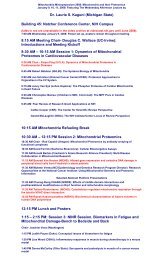RESEARCH ON THE FETUS - National Institutes of Health
RESEARCH ON THE FETUS - National Institutes of Health
RESEARCH ON THE FETUS - National Institutes of Health
Create successful ePaper yourself
Turn your PDF publications into a flip-book with our unique Google optimized e-Paper software.
and whose fetuses were consequently at increased risk. More recently, elevated<br />
levels <strong>of</strong> alpha-fetoprotein in amniotic fluid (or maternal blood) were found to<br />
be associated with neural tube defects, and may serve as a screening test for<br />
these disorders. Ultrasound has come into use to determine internal and external<br />
structural detail <strong>of</strong> the developing fetus and thereby to detect anencephaly,<br />
meningomyelocele, and even congenital heart disease.<br />
Amniocentesis also opened another area <strong>of</strong> fetal research: the assessment<br />
<strong>of</strong> fetal lung maturity. Studies <strong>of</strong> normal amniotic fluid in the last trimester<br />
<strong>of</strong> pregnancy provided an indication that increased concentrations <strong>of</strong> lecithin<br />
relative to sphingomyelin reflect maturation <strong>of</strong> the fetal lung; infants with<br />
mature lungs did not develop respiratory distress. This predictive test (the<br />
L/S ratio) was applied when women went into premature labor, or when induced<br />
delivery was indicated due to Rh disease or maternal diabetes, to assess the risk<br />
that the delivered infant would develop respiratory distress. When the lungs<br />
were immature, delivery could be delayed, depending on the relative risks <strong>of</strong><br />
intrauterine versus extrauterine life. In the last three years, attempts to<br />
induce fetal lung maturation by administration <strong>of</strong> corticosteroids to the mother<br />
have added a new dimension to this clinical situation. Following animal studies<br />
indicating that this procedure was safe and effective, human studies were undertaken<br />
intending to benefit the fetus involved. Results reported to date suggest<br />
that the procedure is successful, but studies <strong>of</strong> possible long-term side effects<br />
<strong>of</strong> this intrauterine therapy are continuing.<br />
Assessment <strong>of</strong> fetal well-being is another goal <strong>of</strong> fetal research. Ultrasound<br />
has been used to assess fetal size and gestational age, and to monitor<br />
fetal respiratory movements, certain types <strong>of</strong> which have been found to indicate<br />
fetal distress. Studies <strong>of</strong> hormones, metabolic products and chemicals in amniotic<br />
fluid (and in maternal blood and urine) identified numerous substances associated<br />
with either abnormalities <strong>of</strong> fetal growth or with fetal distress. In the<br />
last decade, monitoring the fetal heart rate and sampling fetal scalp blood<br />
during labor developed from research techniques to clinical application for indication<br />
<strong>of</strong> fetal distress.<br />
3. Fetal Pharmacology and Therapy. Over 400 publications in the last<br />
10 years involving fetal pharmacology were identified in the literature search;<br />
10











